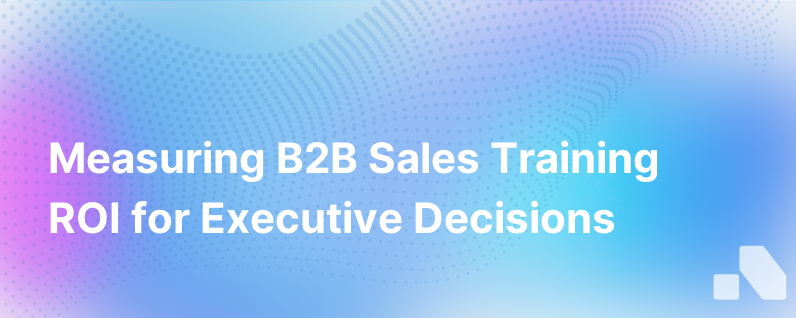
In B2B sales environments, continual improvement is not just a buzzword—it's a necessity. The high-stakes and often complex sales cycles typical in B2B transactions demand that sales teams consistently perform at their peak. One approach to achieving this pinnacle of sales excellence is through ongoing sales training programs. But as with any investment, it's essential to understand and quantify the return on investment (ROI) of these training initiatives. So how do we evaluate whether B2B sales training programs are worth the investment?
Understanding ROI in the Context of Sales Training
To gauge the ROI of B2B sales training, we need a clear picture of what constitutes 'return' and what constitutes 'investment'. The investment is relatively straightforward—it includes the costs of the training program itself, including trainers, materials, and the opportunity cost of taking sales reps away from their daily duties. The return, however, can be more complex to calculate.
Primary Metrics for Evaluating ROI
Multiple metrics can be used to measure the success of a B2B sales training program:
-
Revenue Growth: This is the most direct reflection of training effectiveness. If a sales team secures larger contracts or more deals post-training, that’s a positive indicator of ROI.
-
Deal Conversion Rates: How many leads are being turned into customers? Sales training that equips reps with better qualification and closing skills should see this number increase.
-
Sales Cycle Length: Efficient sales processes save time and resources. If your sales team can close deals faster after training, that's a definitive win.
-
Customer Retention and Upsell Rates: Training might include up-sell, cross-sell, or customer relationship management skills, all of which can increase the lifetime value of a customer.
-
Employee Retention and Satisfaction: If your sales representatives feel more equipped and skilled after training, they're more likely to stay with your company, reducing turnover costs.
Calculating the ROI Formulaically
Calculating ROI involves looking at the profit derived from the training (the revenue growth minus the cost of the training) and dividing it by the cost of the training program:
[ \text{ROI} = \left( \frac{\text{Financial Gain from Training} - \text{Cost of Training}}{\text{Cost of Training}} \right) \times 100 ]
Factors Influencing the ROI of Sales Training
Not all sales training programs are created equal, and several factors can influence their effectiveness:
- Relevance: Is the training content customized to your sales team's specific needs and the unique challenges they face?
- Engagement: Interactive and engaging training sessions are more likely to stick than dull, monotonous presentations.
- Follow-up Reinforcement: Training is often wasted without reinforcement. Ongoing coaching, role-playing, and real-world application help cement new skills.
- Measurement and Tracking: Establishing clear KPIs and tracking improvement over time is necessary to evaluate ROI.
Real-World Impact: Case Studies and Outcomes
Case studies often reveal the benefits of a well-implemented sales training program. Some organizations experience anywhere from 10% to 20% growth in sales productivity. Additionally, improved win rates and shortened sales cycles are common outcomes when training is tailored to address specific gaps in a sales team's skill set.
Leveraging Sales Training for Maximum Return
It's not just about putting your team through a training program—it's also about how you integrate that training into your sales operations:
- Customization: Sales training should be tailored to fit the unique context of your team's sales ecosystem.
- Management Buy-In: Training is most effective when sales management is aligned with program objectives and reinforces the training's importance.
- Sales Enablement Tools: Pair training with tools that enable your sales team to put their new skills into practice, such as CRM software or sales automation platforms.
The Aomni Difference
Aomni stands out by understanding the challenges unique to B2B sales. With a focus on strategic sales, real-time account research, and personalized sales content, Aomni offers a platform that delivers actionable competitive insights. This level of sales intelligence can dramatically enhance the effectiveness of your B2B sales training, ensuring that your team isn't just well-trained but well-armed with the insights and data they need to succeed.
In Conclusion
Evaluating the ROI of B2B sales training programs requires a multi-faceted approach, accounting for direct financial gains as well as indirect benefits such as employee satisfaction and retention. A thoughtful, meticulously implemented sales training program can create significant competitive advantages and contribute to a notable increase in revenue and productivity. With supportive tools like Aomni to streamline the sales process, sales teams can fully leverage their training to close more deals, more efficiently.
Sources:
- The Ultimate Guide to Measuring B2B Marketing ROI
- 11 Ways to Measure ROI of Your Sales Training Program
- How to Calculate the ROI of Digital Advisors in B2B Sales
- How to Reinforce Sales Training to Maximize Your ROI
- How do you calculate ROI for B2B automation?
- Why and How to Determine the ROI of Your Sales Training Program
- 5 Rules for Measuring the ROI of Your Sales Training Program
- Important B2B Sales Enablement Metrics to Measure Performance and ROI | The Sales Blog